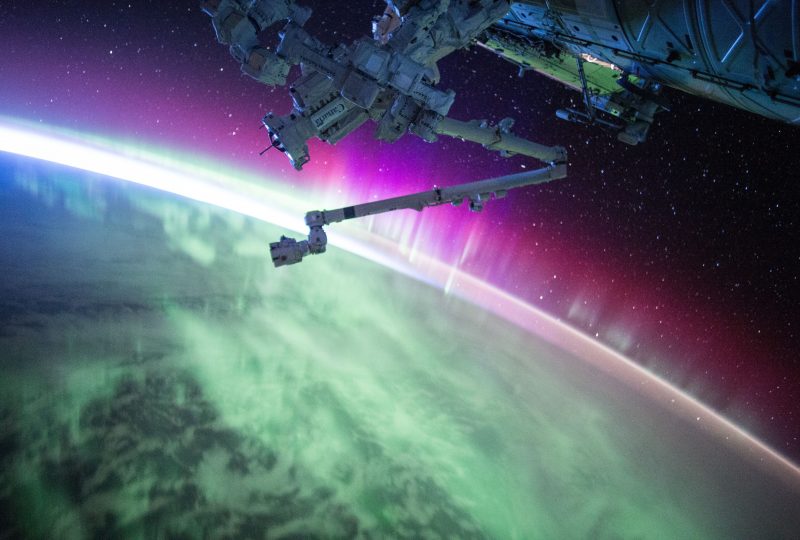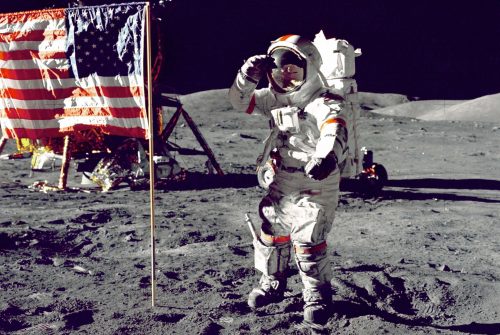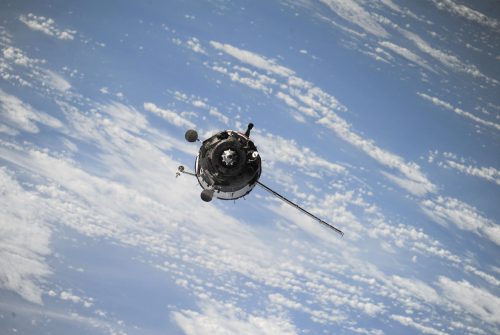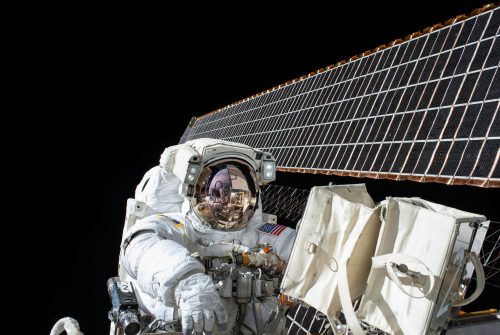The space for everyone: an interview with Adrian Fartade
14 February 2019 | Written by La redazione
We had a chat with the scientific communicator, very popular on Youtube for videos dedicated to astronomy and space and accessible to non-experts

Humanity’s exploration of space has been giving satisfaction to researchers all over the world like never before: only a few weeks ago, for example, the Chinese probe Chang’e-4 made history, landing for the first time on the dark side of the moon. What is certain is that space and planets are being discussed more and more often: this is also why there is a need for new voices able to tell spatial exploration and astronomical research even to non-experts.
Like that of Adrian Fartade, actor and scientific divulger, author of the book “Barefoot on Mars” (Rizzoli), which became famous thanks to the Youtube channel Link4Universe and the Link2Universe Facebook page where he talks about the most recent discoveries in astronomy from all world, presenting them in an accessible and entertaining way.
We asked Adrian to tell us, from his point of view, what is the future of space exploration and what we will have to expect from this constantly changing world.
The “space race” seems to have regained the intensity that distinguished it until the 80s. Why and what does it mean?
What makes the present much more effervescent is, first of all, the increase in space launches by new protagonists, both private, such as SpaceX or BlueOrigin, and national as China or India. But there is not the space race we saw in the past, between two superpowers, but the rapid explosion of a giant new market, which is the satellite for telecommunications, satellite positioning and Earth observation (weather and not), which generates a huge demand for new rockets and space launches, which in turn generates competition and lowers the price of launches, leading to more launches, as well as more innovation in the miniaturization of satellites to be able to launch more and better. In all this innovation has also led to big leaps forward as the reuse of rockets to lower the cost and the creation of entire satellite constellations that in the coming years will bring thousands of small satellites in orbit.
All this also affects the ambitions of individuals and governments in space exploration, robotic and human, with new plans to return to the Moon and to Mars.
The Moon will play a central role in the spatial exploration of the future. What do you think are the next fundamental steps?
First of all, the Moon is a huge treasure from the scientific point of view, although it can still teach us about the history of the Earth, the planets and the solar system in general. An excellent example and how recently we have discovered the most ancient earth crust fragment of all time, in a rock brought back from the Moon by the Apollo astronauts, and arrived there, over 4 billion years ago after the impact of an asteroid on our planet.
However, considering the proximity and the presence of water ice, it could become an outpost for human presence and for the birth of an entire cis-lunar economy, between Moon and Earth.
The next steps will certainly be to bring more robotic probes, both in lunar orbit and on the surface and improve our knowledge about the presence of water and how we can extract it from the ground, along with other resources, to get rocket fuel, oxygen to breathe, water to drink and for protection against radiation, but also all that we need to grow and to be able to print in 3D future environments to survive long on the Moon.
China is already preparing future robotic missions, such as the Chang’e-5 which will start at the end of 2019 to recover up to 2kg of change from the ground and 2 meters in the lunar subsoil. India will launch its first rover on the lunar surface with the Chandrayaan-2 mission this April, while this month it will also arrive the first lander of an independent private company, called SpaceIL, a native of Israel. NASA is working on the launch of a human spacecraft called Orion, around 2020 (unmanned at first and then with astronauts but only in lunar orbit), while SpaceX is working on its SuperHeavy – Starship system, to carry a mission private with 8 artists towards the Moon and back home. The whole system will be reusable altogether, potentially lowering costs for such missions.
While speaking of the Moon, what is the meaning, even from the symbolic point of view, of the birth of the first shoot on a world different from ours?
Seeing a seedling sprouting on the moon was certainly one of the most exciting moments, and symbolically it is a bit the sprouting of a new space era, made of many different companies that collaborate with each other internationally, compared to the old classic rivalries and races to the space to which the world was accustomed half a century ago, at the beginning of the first space age.
In addition, it is also a very strong symbol for China that just after 15 years have passed from the launch of its first mission to the Moon to the already sixth lunar mission, Chang’e-4, complete with biological experiments as well as being the first on the opposite side of the moon.
It also fills me with the fact that the experiment was born of students and was carried out by the universities. Even if the seedling did not last long, dying of cold during the night, they showed however that the seeds can survive the journey and sprout on the Moon.
Not just the future: Among your goals, there is also the one of recover and enhance the history of space exploration…
This year is 500 years since the death of Leonardo Da Vinci, and in Florence, where I live, millions of people will come to see the wonderful works left behind by his genius. I am sure that in the course of centuries, we will think in the same way of the great achievements of this age, which will be remembered as the beginning of the human adventure out of its earthly cradle.
Private companies have started to look at space enterprise like never before. What can their contribution bring?
This is a huge market of hundreds of billions of euros, with rapid growth and a lot of innovation. In the trimmed world of data in which we live (from GPS to weather to traffic data, climate, natural disasters, telecommunications and internet etc.), in the last few decades the demand for launching satellites has increased. So, all around this was born a very florid economy made by many companies that work in the construction of satellites, antennas to communicate from Earth, or rockets to launch them. This has led to thousands of new aerospace companies spread across the world, and it’s a market that is still growing along with the demand for more powerful satellites, or entire constellations of thousands of ultra-fast internet satellites, or new emerging economies that want dedicated satellites to monitor the weather and resources and possible natural disasters in different countries, such as Morocco, Nigeria, Algeria, Egypt, Thailand, Argentina, etc.
The space agencies have a long tradition of collaborating with private individuals, who were contracting everything from rocket engines to rockets to spaceships and space suits. But now, the races are done directly on the entire service, so NASA or ESA simply buy seats for their astronauts and give money to those who guarantee the best service. This also applies to cargo with experiments and supplies for the ISS for example.
Over time, the competition will lead to better compete with lower prices and innovation that will allow us to support for the first time a truly large-scale international aerospace industry. This will be the backbone to allow us to do huge projects like going back to create a base on the Moon and go to Mars. Doing it first would be like launching Facebook in the 80s. Which makes the enterprise of human lunar missions even more extraordinary.
We know more and more about the solar system, but at the same time, there is still a lot to discover. What is the question that, more than any other, fascinates you and you would like an answer for?
As much as I can try to choose, the thing I love most about the exploration of the Solar System is that the questions are like only pieces of a bigger puzzle and are linked to each other. Why Mars does not have a magnetic field is related to why Venus does not have a magnetic field. How come Uranus turns sideways in this way, inclined at 98 °, is related to why there are only 2 gaseous giants and 2 icy and no more?
If I had to choose, however, I would very much like to know if there ever was or if there is life somewhere else in the Solar System as well as the Earth. I think it is by far the single most impactful discovery we can do!
Youtuber, but also a theatrical actor and guest on radio and TV. Which of these channels are you most fond of and which, in your opinion, is more suitable for communicating science?
As a theatrical actor, first of all, I love being able to stay in direct contact with people, and I believe that nothing can replace how good it is to be able to tell stories together live.
That said, however, I think that every media can work differently, but I really love YouTube for the possibility of reaching people directly, in an interactive, creative and authentic way. It is not always easy to see through the “noise” of videos that do not interest us on YouTube, but the platform is huge, and it is often like being in a vast library without knowing before that book open, and having to judge only from the cover. But this does not mean that the contents are not there, on the contrary, and the more time passes the more channels emerge. One thing I do not like is that they are called “talent” because knowing my colleagues, I know how much difference makes work and sacrifice and sleepless nights and years of dedication.
This generation has the opportunity to invent more ways to tell stories than ever before, reaching more people than ever before. I have a lot of confidence, especially looking at the very young of today, that beauty has yet to come.
Being able to choose, for your holidays in 2050 on which planet would you like to go?
Pluto! It is the (dwarf) planet that I would die more to visit on its surface. I also love Uranus but alas it has no surface even if it compensates with an ocean of diamonds and a wonderful system of moons.
On Pluto, however, there are mountains of water ice as large as the Alps, with icy methane snow above it being pushed away by the wind to a fluid ocean below made of frozen nitrogen that moves like a lava lamp. It is simply one of the most incredible and beautiful and strange scenarios imaginable.
I also like to imagine that future generations will start towards races on which human will first put fully on Pluto, as a symbol of distant frontier, a little ‘how it happened on Earth with the race to the South Pole in Antarctica!
We just have to eat healthily and exercise to live long enough to see it! In the meantime, you all continue to be wonderful.









